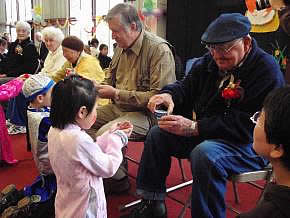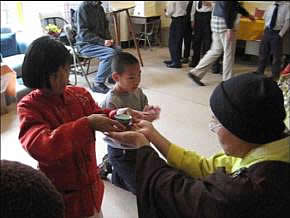 |
|
 |
A Valuable Lesson Learned
By Bhikshu Heng Sure, Ph.D. in Religion
Master Hsuan Hua started his first free school at age eighteen. He took charge of the teaching duties and provided education for the children of his neighboring farm villages. From that time on, cultivation of the Buddha’s teaching and education have always been closely related in the Dharma Realm Buddhist Association.
Master Hsuan Hua taught the complete spectrum of the Dharma, from lessons in humanity all the way to Buddhahood. That is to say, around the monasteries of the DRBA we rarely hear talk of who is enlightened, or who has psychic powers, but we do discuss how to enrich one’s character, or who has learned to control her temper. The key phrase is “Learn from the Buddha, and first become a good person. When you can become a good person to the ultimate point, Buddhahood accomplishes itself.”
So in the 21st century, as at the beginning of the teachings, cultivating to Buddhahood begins with one’s character. In our schools we don’t ask the students to spout catechism slogans or to parrot Buddhist phrases. We do ask them to show respect to their teachers and elders and to repay the kindness of their parents. The virtue of filial respect is indeed the beginning of both great wisdom and great compassion.

I taught third grade at Instilling Goodness Elementary School, and I consider it the most difficult cultivation I’ve done. The students tested my patience at every hand and pushed the limits of my creative imagination with every class. I came back to Tathagata Monastery after a day in the classroom utterly exhausted. The boys had drained all my energy and had run off to play basketball after school while I looked for a place to lie down. They taught me that I hadn’t learned to control my temper or to protect my energy at all: quite a valuable lesson learned from the students in a simple English literature class.
I wrote a song for the third grade English students: “We like to read; there’s so much to know; we like to read, and watch our wisdom grow.” The song listed the many kinds of reading material. I thought the students were bored; ten years later one of the boys, now quite grown up, returned to say how much he and his classmates had enjoyed the song; some of them still knew the tune. He said that singing about the various kinds of reading material actually inspired him to look into encyclopedias, histories, storybooks, and newspapers.
We read Standards for Students (Dizi Gui) a classic of elementary education from China’s past, and a book that Master Hua valued. I created a learning club for the boys based on a goofy-looking eagle named Sanford the Standard Bird. Sanford praised “Rules Eagles” and I drew up a certificate embossed with pictures of eagles as an encouragement to any boy who could memorize the Standards for Students text. I still have copies of the certificate as well as the name list of the recipients.
I recall a prediction that Master Hua gave during one of his morning lectures at the City of Ten Thousand Buddhas. He said, “One hundred years from now, as people look back at the dawn of the Dharma in the West, they will say, ‘Oh, the Buddhists? Yes, I know them. I send my children to their schools. They teach them to be good people.’” After thirty years of pursuing academic excellence based on instilling goodness and developing virtue, I think Buddhism’s road ahead is straight and our compass bearing is set.

